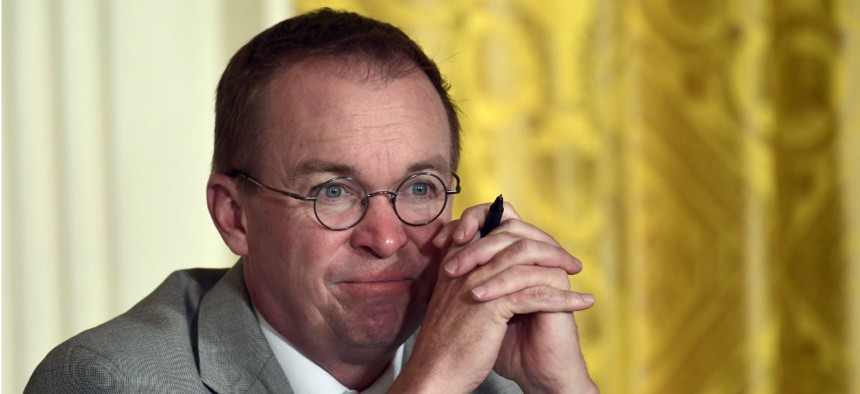
OMB Director Mick Mulvaney issued the memos. Susan Walsh/AP
OMB Sharpens Guidance for Improving Programs and Curbing Improper Payments
Mulvaney seeks to reduce reporting burdens as agencies appoint new management officers.
In a pair of memos to agency heads this week, White House Budget Director Mick Mulvaney laid out how his office will monitor progress toward formalizing the improvement of program management and getting a better handle on long-standing efforts to avoid government payments to undeserving parties.
The first memo, dated June 25, follows through on the 2016 Program Management Improvement Accountability Act, which requires appointment of program management improvement officers and created a new interagency council to enhance program and project management techniques.
The memo sets July 27, 2018, as the deadline for appointment of a senior executive as program management improvement officer, if this hasn’t happened already. Each agency’s overall implementation plan for the program management agenda is then due by Nov. 30, in time for a governmentwide OMB report planned for the winter.
Mulvaney wrote of three implementing strategies, focused on requirements under the Government Performance and Results Modernization Act as well as a review of items on the high-risk list produced by the Government Accountability Office.
The first addressed coordinated governance, with leadership from chief operating officers and collaboration within each agency. The second involved regular OMB and agency engagement and portfolio reviews to identify barriers to good outcomes. And the third addressed strengthening the programs’ management capacity while building “a capable” program management workforce through training, career paths and mentorships.
The second OMB memo, dated June 26, revised a 2014 OMB Circular 123 appendix to “create a more unified, comprehensive, and less burdensome set of requirements.”
All programs reporting an improper payment estimate “should identify the reasons their programs and activities are at risk of improper payments,” it stated. “Corrective actions developed and implemented by agencies should be responsive to the root causes of the improper payments….Distinguishing between what constitutes a root cause that created an error versus an internal control problem that did not catch an error is critical when creating corrective actions to address improper payments,” it said, calling for measurements of annual progress of each individual corrective action.
In addition, the improper payments memo laid out criteria OMB will use in reviewing agency requests for relief from reporting deadlines. OMB will gauge the “burden—does measuring and reporting improper payments lead to a heavy burden (e.g., in terms of funding, program staff hours, etc.)?”—as well as any relevant legislative requirements and audit findings by inspectors general that “point to reasons why the program might need to continue measuring and reporting improper payments.”
Linda Miller, director of the Fraud Risk Mitigation Practice at Grant Thornton LLP, praised the improper payments guidance for its clarity in its effort to reduce the reporting burden. “It’s clear that they are trying to push agencies to do more rigorous qualitative assessments and relieving them of the burden of doing more costly quantitative assessments if they have a robust qualitative process,” she told Government Executive.
In addition, “OMB is using the term ‘payment integrity,’ which I think is a very helpful way to think about improper payments as it encompasses the whole system an agency has in place to safeguard the integrity of the payments it makes. As agencies start to see payment integrity as a set of activities, which includes prepayment analytics,” Miller added, “they will start to move the needle in actually reducing the payments they make improperly, rather than focusing on estimation and reporting for improper payment compliance purposes.”







